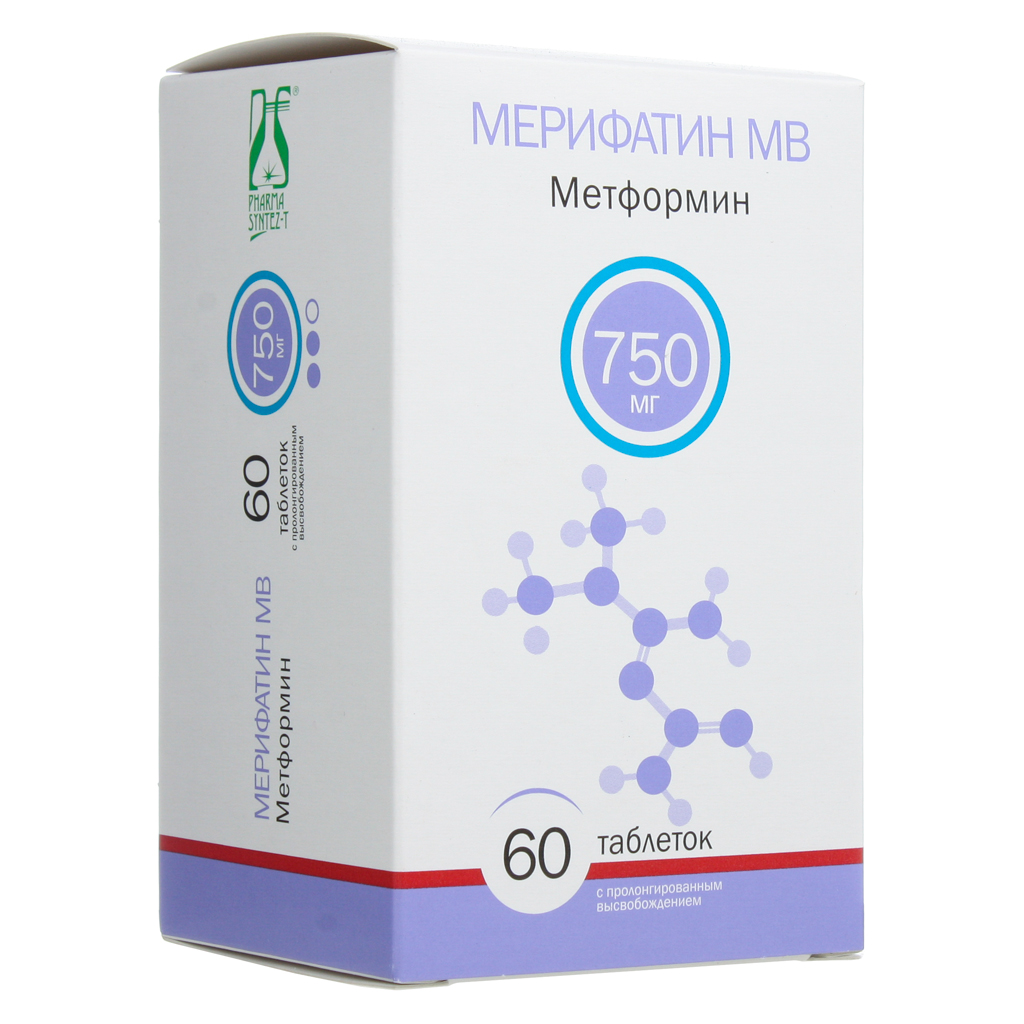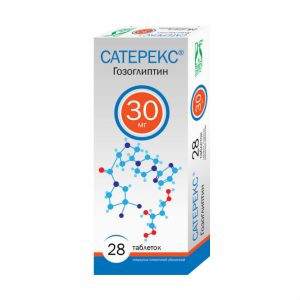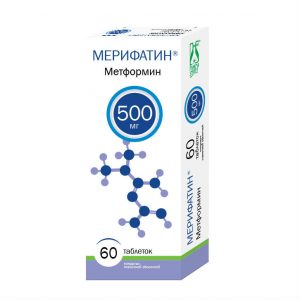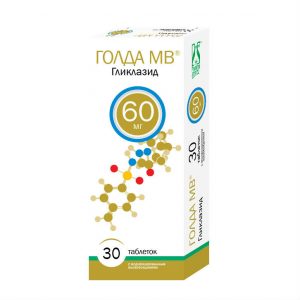Description
Pharmacological action
Metformin is a biguanide with a hypoglycemic effect that reduces both basal and postprandial plasma glucose concentrations. Does not stimulate insulin secretion and therefore does not cause hypoglycemia. Increases the sensitivity of peripheral receptors to insulin and the utilization of glucose by cells. Reduces liver glucose production by inhibiting gluconeogenesis and glycogenolysis. Delays intestinal absorption of glucose.
Metformin stimulates glycogen synthesis by acting on glycogen synthase. Increases transport capacity of all types of membrane glucose transporters.
In patients receiving metformin, the patient ² ¢s body weight either remains stable or decreases moderately. Metformin has a beneficial effect on lipid metabolism: it lowers total cholesterol, LDL (low density lipoproteins) and triglycerides.
Pharmacokinetics:
Absorption of
After a single dose of sustained release metformin (sustained release tablets 500 mg and 750 mg) at a dose of 1500 mg, the average time to reach maximum plasma metformin concentration (Tmax) is 5 hours (range 4-12 hours). After a single dose of 1 tablet of sustained release metformin at a dosage of 1000 mg after a meal, the average Tmax is 5 hours (in the range of 4-10 hours).
In an equilibrium state identical to the equilibrium state of metformin with normal release, the maximum concentration (Cmax) and the area under the concentration-time curve (AUC) increase not proportionally to the dose taken. AUC after a single dose of metformin with a sustained release at a dose of 2000 mg is similar to that observed after administration of metformin with a normal release at a dose of 1000 mg 2 times a day.
Intra-individual variability of Cmax and AUC after administration of metformin in the form of sustained release tablets is similar to that observed after administration of metformin with conventional release.
After a single dose of metformin with a prolonged release of 1000 mg after a meal, AUC increases by 77%, Cmax increases by 26% and TCmax increases by about 1 hour. Absorption of metformin with a prolonged release does not change depending on the composition of the food taken.
No cumulation was observed with repeated administration of metformin with a sustained release in a dose of up to 2000 mg.
Distribution
Metformin is rapidly distributed in the tissue, practically does not bind to plasma proteins, and is able to accumulate in red blood cells. Cmax in blood is lower than Cmax in blood plasma and is reached in about the same time. The average volume of distribution is 63-276 liters.
Metabolism
Metabolized to a very low degree, no metabolites in the body.
Excretion
Excreted by the kidneys unchanged. The clearance of metformin in healthy volunteers is more than 400 ml / min (4 times more than creatinine clearance), which indicates the presence of active tubular secretion.
The elimination half-life is approximately 6.5 hours.
Impaired renal function
With impaired renal function, metformin clearance decreases in proportion to creatinine clearance (CC), respectively, the half-life increases, the concentration of metformin in the blood plasma rises, the risk of cumulation increases.
Indications
Type 2 diabetes mellitus in adults (especially in obese patients) with dietary and exercise stress:
as a monotherapy for
in combination with other oral hypoglycemic agents or with insulin.
Contraindications
– Hypersensitivity to metformin or to any auxiliary substance
– diabetic ketoacidosis, diabetic precoma, coma
– renal failure or impaired renal function (QC less than 30 ml / min)
with acute renal function – acute : dehydration (with chronic or severe diarrhea, repeated attacks of vomiting), severe infectious diseases (for example, respiratory infections, urinary tract infections), shock
– clinically expressed royavleniya acute or chronic disease that may lead to the development of tissue hypoxia (including acute heart failure, chronic heart failure, unstable hemodynamics, respiratory distress, acute myocardial infarction)
– extensive surgery and trauma when insulin therapy is indicated (see Special instructions)
– liver failure, impaired liver function
– chronic alcoholism, acute alcohol intoxication
– pregnancy
– lactic acidosis (incl. and in history)
– application for less than 48 hours before and within 48 hours after conducting radioisotope or x-ray studies with the introduction of an iodine-containing contrast medium (e.g., intravenous urography, angiography) (see action with other drugs)
– adherence to a low-calorie diet (<1000 cal / day) – age under 18 years (due to the lack of data on the efficacy and safety of use in this age group). Caution: – In patients older than 60 years who perform heavy physical work, which is associated with an increased risk of developing lactic acidosis in patients with renal failure (CC 30-59 ml / min) – during breastfeeding. Special instructions Lactic acidosis Lactic acidosis is rare. but a serious (high mortality rate in the absence of emergency treatment) complication that may occur due to cumulation of metformin. Cases of lactic acidosis when taking metformin occurred mainly in patients with diabetes mellitus with severe renal failure. Other related risk factors should be considered, such as decompensated diabetes mellitus, ketosis, prolonged fasting, alcoholism, liver failure, and any condition associated with severe hypoxia, severe infectious disease, and concomitant use with certain medications. This can help reduce the incidence of lactic acidosis. The risk of lactic acidosis should be considered when non-specific symptoms appear, such as muscle cramps accompanied by dyspeptic disorders, abdominal pain, and severe asthenia. Lactic acidosis is characterized by severe malaise with general weakness, acidotic shortness of breath and vomiting, abdominal pain, muscle cramps and hypothermia followed by coma. Diagnostic laboratory parameters are a decrease in blood pH (less than 7.35), a concentration of lactate in the blood plasma of more than 5 mmol / l, an increased anion gap and the ratio of lactate / pyruvate. If you suspect a lactic acidosis, you must stop taking the drug and consult a doctor immediately. Intravascular administration of iodine-containing radiopaque agents can lead to the development of renal failure and cumulation of metformin, which increases the risk of lactic acidosis. Metformin must be discontinued, depending on renal function, 48 hours before or during an X-ray examination using iodine-containing radiopaque agents, and do not resume taking it earlier than 48 hours after it, provided that renal function was found to be normal during the examination. Surgery Metformin should be discontinued 48 hours before elective surgery and can be continued no earlier than 48 hours after the condition that renal function was found to be normal during the examination. Renal function Since metformin is excreted by the kidneys, it is necessary to determine serum content and / or KK in serum before starting treatment and regularly thereafter: at least 1 time per year in patients with normal kidney function and 2-4 times per year in elderly patients, and also in patients with CC on the lower limit of normal. Special care should be taken in case of possible impaired renal function in elderly patients, while the use of antihypertensive drugs, diuretics or non-steroidal anti-inflammatory drugs. With dehydration (chronic or severe diarrhea, repeated bouts of vomiting). Heart failure Patients with heart failure have a higher risk of developing hypoxia and kidney failure. Patients with chronic heart failure should be regularly monitored for cardiac renal function while taking metformin. Metformin administration in acute heart failure and chronic heart failure with unstable hemodynamic parameters is contraindicated. Other Precautions – Patients are advised to continue on a diet with an even intake of carbohydrates throughout the day. Overweight patients are advised to continue to follow a low-calorie diet (but not less than 1000 kcal / day). Also, patients should regularly exercise. – Patients should inform their doctor of any treatment given and any infectious diseases, such as colds, respiratory infections, or urinary tract infections. – It is recommended that routine laboratory tests be performed to monitor diabetes. – Metformin does not cause hypoglycemia during monotherapy, but caution is advised when used in combination with insulin or other oral hypoglycemic agents (e.g. derivatives of sulfonylureas or repaglinide, etc.). Symptoms of hypoglycemia are weakness, headache, dizziness, sweating, palpitations, blurred vision, or impaired attention. – It is necessary to warn the patient that the excipients of the drug Merifatin MV can be excreted unchanged through the intestines, which does not affect the pharmacological effect of the drug. Impact on the ability to drive transp. Wed and fur .: Monotherapy with the drug Merifatin MV does not cause hypoglycemia, therefore, does not affect the ability to drive vehicles and mechanisms. Nevertheless, the development of hypoglycemia is possible with the use of metformin in combination with other hypoglycemic drugs (sulfonylureas, insulin, repaglinide, etc.). When symptoms of hypoglycemia appear, you should not drive vehicles and mechanisms. Composition Per tablet: Active ingredient: metformin hydrochloride – 750 mg. Excipients: hypromellose 2208 – 384.0 mg sodium carmellose (sodium carboxymethyl cellulose) – 42.0 mg hyprolysis (hydroxypropyl cellulose) – 15.0 mg copovidone – 3.0 mg magnesium stearate – 6.0 mg. Dosage and Administration Inside. The tablets are swallowed whole without chewing, washed down with a small amount of liquid, 1 time / day during dinner. The dose of the drug Merifatin MV is selected by the doctor individually for each patient based on the results of determining the concentration of blood glucose. Adult patients with normal renal function (KK 90 ml / min) Monotherapy and combination therapy in combination with other hypoglycemic agents – The drug Merifatin MB in a dose of 1000 mg should be taken once a day (once / day) during dinner. – The drug Merifatin MB at a dose of 1000 mg is prescribed as maintenance therapy for patients taking metformin with a usual release at a dose of 1000 mg or 2000 mg. To switch to the drug Merifatin MV at a dose of 1000 mg, the daily dose of metformin should be equivalent to the daily dose of metformin with the usual release. – Patients taking metformin in the form of tablets with a usual release in a dose exceeding 2000 mg, it is not recommended to switch to the drug Merifatin MV in a dose of 1000 mg. – For patients not taking metformin, the recommended starting dose of Merifatin MV is 500 mg or 750 mg once daily during dinner. Every 10-15 days, it is recommended to adjust the dose based on the results of determining the concentration of blood glucose. Slow dose increase helps to reduce side effects from the gastrointestinal tract (GIT). – In the case of a transition from another hypoglycemic agent, the dose is selected as described above, starting with the administration of the drug Merifatin MV at a dose of 500 mg or 750 mg, with a possible subsequent transition to the drug Merifatin MV at a dose of 1000 mg. Combination with insulin To achieve better control of blood glucose concentrations, metformin and insulin can be used as a combination therapy. The usual initial dose of Merifatin MV is 1 tablet 500 mg 1 time per day or 750 mg 1 time per day during dinner, while the dose of insulin is selected based on the results of determining the concentration of blood glucose. Further, the transition to the drug Merifatin MV at a dose of 1000 mg is possible. Daily dose The maximum recommended dose of Merifatin MV is 4 tablets 500 mg per day (2000 mg) or 3 tablets 750 mg per day (2250 mg) or 2 tablets 1000 mg per day (2000 mg). If, when taking the maximum recommended dose 1 time / day during dinner, it is not possible to achieve adequate glycemic control, then the maximum dose can be divided into two doses: 2 tablets of 500 mg during breakfast and 2 tablets of 500 mg during dinner or one 1000 mg tablet during breakfast and one 1000 mg tablet during dinner. If adequate glycemic control is not achieved when taking the maximum recommended dose of the drug Merifatin MV sustained-release tablets, it is possible to switch to metformin with the usual release of the active substance with a maximum daily dose of 3000 mg. Use of the drug in special clinical groups of patients Skip dose If you skip taking the next dose, the next dose should be taken at the usual time. Do not take a double dose of Merifatin MV. Patients with Renal Insufficiency Metformin may be used in patients with renal insufficiency of KK 30 59 ml / min only in the absence of conditions / risk factors that may increase the risk of lactic acidosis. Elderly patients Due to a possible decrease in renal function, the dose of metformin is adjusted based on an assessment of renal function, which should be performed regularly. Children and adolescents under 18 The use of the drug is contraindicated in children and adolescents under the age of 18 (due to the lack of clinical data on efficacy and safety). Duration of treatment Merifatin MV should be taken daily, without interruption. If treatment is discontinued, the patient should inform the doctor. Kidney function should be closely monitored: CC should be determined every 3-6 months in patients with CC of 45-59 ml / min and every 3 months with CC of 30-44 ml / min. If creatinine clearance is below 30 ml / min, metformin should be discontinued immediately. Side effects Classification of the frequency of occurrence of HP when using the drug according to the recommendations of the World Health Organization (WHO): very often ( 1/10) often ( 1/100, <1/10) infrequently ( 1/1000, <1 / 100) rarely ( 1/10000, <1/1000) very rarely (<1/10000). From the side of metabolism: very rarely – lactic acidosis. With prolonged use of metformin, a decrease in absorption of vitamin B12 may be observed. If megaloblastic anemia is detected, the possibility of such an etiology must be considered. From the side of the nervous system: often – taste disturbance (metallic taste in the mouth). From the gastrointestinal tract: very often – nausea, vomiting, diarrhea, abdominal pain and lack of appetite. Most often they occur in the initial period of treatment and in most cases pass spontaneously. To prevent symptoms, it is recommended that you take metformin during or after a meal. Slow dose increases can improve gastrointestinal tolerance. From the liver and biliary tract: very rarely – impaired liver function and hepatitis after drug withdrawal, these HPs completely disappear. From the skin and subcutaneous tissues: very rarely – skin reactions, such as erythema (redness of the skin), itching, urticaria. If any of the HPs listed in the instructions are aggravated or other HPs that are not listed on the instructions appear, you should inform your doctor. Overdose of When metformin was used in a dose of up to 85 g (42.5 times the maximum daily dose), no episodes of hypoglycemia were observed. However, in this case, the development of lactic acidosis was observed. Significant overdose or associated risk factors can lead to the development of lactic acidosis. Symptoms of lactic acidosis are: severe weakness, myalgia, abdominal pain, respiratory disorders, increased drowsiness. In severe lactic acidosis, the development of arterial hypotension and resistant bradyarrhythmia was noted. Treatment: in case of signs of lactic acidosis, the drug should be stopped immediately, the patient should be hospitalized urgently and, Having determined the concentration of lactate, clarify the diagnosis. The most effective measure to remove lactate and metformin from the body is hemodialysis. Symptomatic treatment is also carried out. Storage conditions Store in a dark place at a temperature not exceeding 25 ° C. Keep out of the reach of children. Expiration 3 years. Do not use after expiration date. Deystvuyuschee substances Metformin drugstore conditions drugstore Dosage form tablets prolong.




